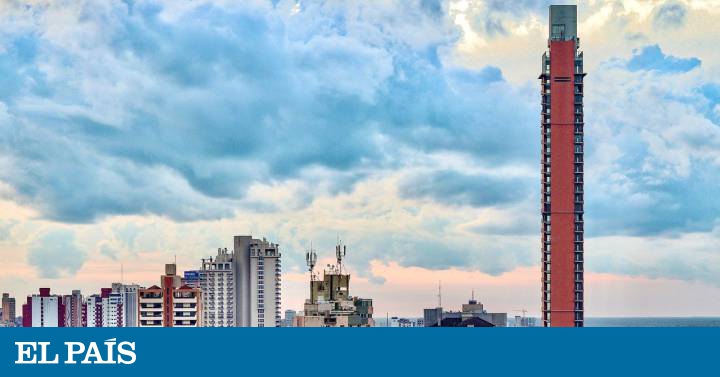Since 2012, Costanera Avenue, which receives traffic arriving from the airport and reaching the center of Asunción, borders the city's bay and surrounds three of its neighborhoods as it approaches the historic center. Curiously, what this distant colonial center announces are two contrasts: a light and red tower, nailed to the landscape, and a residential blanket, a self-built settlement known as La Chacarita.
The column that marks the landscape, with a vertical line 140 meters high, is called the Icon Tower but, paradoxically, it tries to appear and disappear at the same time. That is to say: it is seen from afar more because it is red than because it is tall. You notice it because it is both elegant and drastic, a visual paradox that is at once blurred, immaterial and outstanding. That is its main attribute: contrast and absentmindedness. Contrary to most of the high-rise buildings signed by its author, the architect Carlos. A. Jiménez and his studio Estarq, –more conventional residential towers with cantilevered terraces to catch and flee from the sun– this skyscraper is a light tower, almost a habitable sculpture. The building is also an affirmation of respect, a minimalist and drastic work at the same time, a daring proposal that leads directly from scarcity to the future.
The cloak, almost at the foot of the tower, La Chacarita, is the most emblematic self-built neighborhood in the city. One of the neighborhoods with more flavor - and problems - in Asunción. A place that the last Biennial of Ibero-American Architecture had the courage to designate as the setting for the exhibition, in order to publicize how a large part of the population lives in Latin America. And in the world. It could be seen then that scarcity - and the urgent need to improve sewerage and sanitation - is not at odds with spatial, neighborhood quality, human scale and shared public space. The proximity to the center and the ease with which most of the inhabitants get to their job - walking - is an indication of the future. On the contrary, the need to trust in self-construction and the neglect of allegation are questions of the past that must be resolved without resorting to the drastic and unjust solution of the general eviction. On how the historical center of Asunción manages its poverty, its ingenuity, its history, its truth and its density, largely depends on its future. Beyond economic profitability and social justice, cities have a history that they must allow to emerge so as not to cease to be.
But cities also have a future with which they must learn to live together. And the future also goes through living with the tower. Of the Carlos Jiménez, drastic and shy, the first thing you see is the color red, as is the case with the Art Museum that Lina Bo Bardi erected in Sao Paulo (1987). And the second thing that attracts attention is its lightness. Although it was completed almost three decades ago - before the Costanera avenue to which it now greets was devised - the skyscraper is still sparsely inhabited. It seems under construction. But it is finished. This dematerialization is due to the fact that the edges of the prism are released by the terraces. There is contact, and ventilation, between the bay and the lushness of the palm trees and the lapachos that the center cannot miss. But it is the red planes that give the building its drastic image.
Its height, 140 meters, doubles that of the city's skyline . But in front of the wide and compact buildings that abound in urban planning, this tower highlights it, announces it with its light and colored structure. More than an icon, its lightness makes it the anti-icon.
The interior also speaks of a deep-rooted future. As in many Paraguayan homes, the kitchen and living room occupy the same space on the open floor of a loft . Jiménez explains that the building - he does not speak of skyscrapers - takes advantage of the best views of the city: the river and the green horizon, without shading its neighbors.
And he is right. That is why Jiménez, who is a professor of projects at the National University of Asunción and presides over the College of Architects of his country, quotes the writer Isak Dinesen to conclude: "The world has been made to be seen from above." Its Icon tower makes it possible. It is not an icon, it is a lighthouse.

